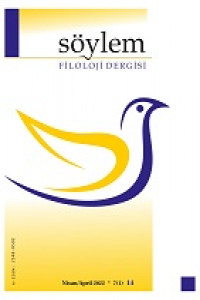Abstract
Dilin kökeni ve akrabalık sınırlarının tespiti, yüzyıllardır araştırmacıların ilgisini çekmiş konulardır. 19. yüzyılda karşılaştırmalı dilbilimin ilke ve yöntemlerinin tam olarak belirlenmesiyle birlikte, bilimsel akrabalık çalışmaları başlamıştır. Bu çalışmalarla kimi dillerin köken bilgileri ve genetik ilişkileri ortaya çıkarılmıştır. Yaşanan bilimsel ve teknolojik gelişmeler ve farklı disiplinlerden gelen bilgilerle, dillerin genetik akrabalığının incelenmesinde kullanılabilecek farklı ölçütler geliştirilmiş; var olan ölçütlerin güvenilirliği incelenmiştir. Tarım kültürünün dil ailelerinin oluşumuna etkisi de son dönemlerde dile getirilen ve farklı dil aileleri üzerinden incelenen bir ölçüttür. Bu kültürün dil ailelerinin oluşumuna doğrudan etkili olduğu farklı örneklerde tespit edilebilmektedir. Dünya dillerinin yanı sıra Altay dil birliğindeki diller de tarım kültürünün izlerini taşımaktadır.
Keywords
Dil Aileleri Dil İlişkileri Tarım Kültürü Tarihi-Karşılaştırmalı Dilbilim Altay Dilleri Ailesi
References
- Akar, A. (2010). Lehçe Oluşma Şartları ve Evreleri Bakımından Eski Türkiye Türkçesi. TÜBAR- XXVIII- Güz.
- Diamond, J. (2010). Tüfek, Mikrop ve Çelik. Ankara: TÜBİTAK.
- Dybo, A. (1997). K kul’turnoj leksike praaltajskogo jazyka. Balto-Slavjanskie issledovania 1998-1996: 164-177.
- EDAL= Starostin, S., Dybo, A. ve Mudrak, O. (2003). Etymological Dictionary of the Altaic Languages. Leiden&Boston: Brill.
- Hall, S.S. (2008). Son Neandertal. National Geographic, Ekim 2008.
- Kincses-Nagy, È. (2016). Türkçe-Macarca Dil İlişkileri. (Yayımlanmamış Bildiri). Hacettepe Üniversitesi Çağdaş Türk Lehçeleri ve Edebiyatları. Ankara.
- Lewin, R. (2008). Modern İnsanın Kökeni. (N. Özaydın, Çev.). Ankara: TÜBİTAK.
- Picq vd. (2013). Dilin En Güzel Tarihi. (S. Rifat, Çev.). İstanbul: İş Bankası.
- Robbeets, M. (2017a). Farming/Language Dispersal, Food for Thought. Language Dispersal Beyond Farming. (M. Robbeets ve A. Savelyev, Ed.). Amsterdam/ Philadelphia: John Benjamins Publishing Company.
- Robbeets, M. (2017b). The Language of the Transeurasian Farmers. Language Dispersal Beyond Farming. (M. Robbeets ve A. Savelyev, Ed.). Amsterdam/ Philadelphia: John Benjamins Publishing Company.
- Robbeets, M. & Bouckaert, R. (2018). Bayesian phylolinguistics reveals the internal structure of the Transeurasian family. Journal of Language Evolution. 145-162.
- Róna-Tas, A. (1975). The Altaic Theory and the History of a Middle Mongolian Loan Word in Chuvash. Researches in Altaic Languages. Budapest.
- Róna-Tas, A. & Berta, A. (2011). West Old Turkic. Wiesbaden: Harrassowitz Verlag.
- Savalyev, A. (2017). Farming-related Terms in Proto-Turkic and Proto-Altaic. Language Dispersal Beyond Farming. (M. Robbeets ve A. Savelyev, Ed.). Amsterdam/ Philadelphia: John Benjamins Publishing Company.
- User, Hatice Şirin (2008). Kamil Stachowski, Names of Cereals in the Turkic Languages, Studia Turcologica Cracoviensia 11, Edited by Stanislaw Stachowski, Krakow 2008: Jagiellonian University Institute of Oriental Philology, TDAY-Belleten. 56: 2008/2.
- Whitman, J. (2011). Northeast Asian Linguistic Ecology and the Advent of Rice Agriculture in Korea and Japan. Rice (2011) 4: 149-158.
The Effect of Agricultural Culture on the Creation of Language Families And Example of Altaic Language Family
Abstract
Determining the origin of language and kinship boundaries are issues that have attracted the attention of researchers for centuries. In the 19th century, with the exact determination of the principles and methods of comparative linguistics, scientific kinship studies began. With these studies, the origins and genetic relationships of some languages were revealed. With the scientific and technological developments experienced and information from different disciplines, different criteria have been developed that can be used in the examination of the genetic relationship of languages; the reliability of the existing criteria was examined. The effect of agricultural culture on the formation of language families is a criterion that has been recently expressed and analyzed through different language families. It has been determined in different examples that this culture has a direct effect on the formation of language families. In addition to the world languages, the languages of the Altaic language union also bear the traces of agricultural culture.
Keywords
Language Families Language Contacts Agricultural Culture Historical Linguistic Comparative Linguistic Altaic Language Family
References
- Akar, A. (2010). Lehçe Oluşma Şartları ve Evreleri Bakımından Eski Türkiye Türkçesi. TÜBAR- XXVIII- Güz.
- Diamond, J. (2010). Tüfek, Mikrop ve Çelik. Ankara: TÜBİTAK.
- Dybo, A. (1997). K kul’turnoj leksike praaltajskogo jazyka. Balto-Slavjanskie issledovania 1998-1996: 164-177.
- EDAL= Starostin, S., Dybo, A. ve Mudrak, O. (2003). Etymological Dictionary of the Altaic Languages. Leiden&Boston: Brill.
- Hall, S.S. (2008). Son Neandertal. National Geographic, Ekim 2008.
- Kincses-Nagy, È. (2016). Türkçe-Macarca Dil İlişkileri. (Yayımlanmamış Bildiri). Hacettepe Üniversitesi Çağdaş Türk Lehçeleri ve Edebiyatları. Ankara.
- Lewin, R. (2008). Modern İnsanın Kökeni. (N. Özaydın, Çev.). Ankara: TÜBİTAK.
- Picq vd. (2013). Dilin En Güzel Tarihi. (S. Rifat, Çev.). İstanbul: İş Bankası.
- Robbeets, M. (2017a). Farming/Language Dispersal, Food for Thought. Language Dispersal Beyond Farming. (M. Robbeets ve A. Savelyev, Ed.). Amsterdam/ Philadelphia: John Benjamins Publishing Company.
- Robbeets, M. (2017b). The Language of the Transeurasian Farmers. Language Dispersal Beyond Farming. (M. Robbeets ve A. Savelyev, Ed.). Amsterdam/ Philadelphia: John Benjamins Publishing Company.
- Robbeets, M. & Bouckaert, R. (2018). Bayesian phylolinguistics reveals the internal structure of the Transeurasian family. Journal of Language Evolution. 145-162.
- Róna-Tas, A. (1975). The Altaic Theory and the History of a Middle Mongolian Loan Word in Chuvash. Researches in Altaic Languages. Budapest.
- Róna-Tas, A. & Berta, A. (2011). West Old Turkic. Wiesbaden: Harrassowitz Verlag.
- Savalyev, A. (2017). Farming-related Terms in Proto-Turkic and Proto-Altaic. Language Dispersal Beyond Farming. (M. Robbeets ve A. Savelyev, Ed.). Amsterdam/ Philadelphia: John Benjamins Publishing Company.
- User, Hatice Şirin (2008). Kamil Stachowski, Names of Cereals in the Turkic Languages, Studia Turcologica Cracoviensia 11, Edited by Stanislaw Stachowski, Krakow 2008: Jagiellonian University Institute of Oriental Philology, TDAY-Belleten. 56: 2008/2.
- Whitman, J. (2011). Northeast Asian Linguistic Ecology and the Advent of Rice Agriculture in Korea and Japan. Rice (2011) 4: 149-158.
Details
| Primary Language | Turkish |
|---|---|
| Subjects | Linguistics |
| Journal Section | DİLBİLİM / ARAŞTIRMA MAKALELERİ |
| Authors | |
| Publication Date | April 29, 2022 |
| Submission Date | January 5, 2022 |
| Acceptance Date | February 16, 2022 |
| Published in Issue | Year 2022 Volume: 7 Issue: 1 |

This work is licensed under a Creative Commons Attribution-NonCommercial-NoDerivatives 4.0 International License.


